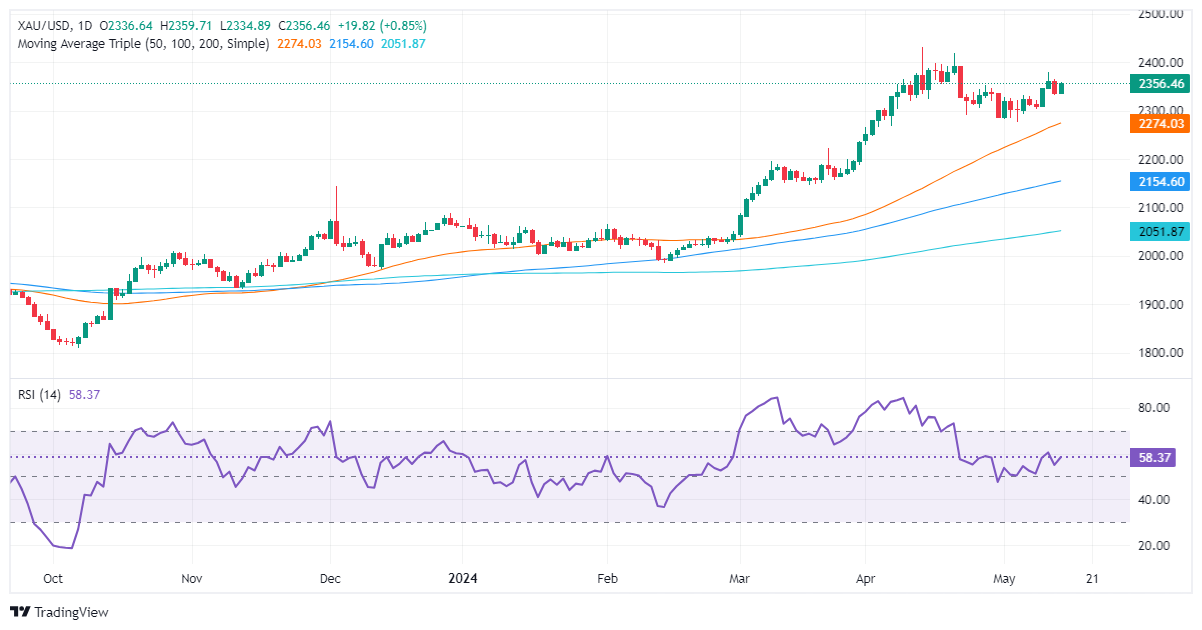Gold price firmer amid mixed US PPI data, Fed’s uncertain on inflation

- Gold jumps 0.97% after US producer price data shows higher-than-expected inflation.
- Despite a spike, Treasury yields reversed to 4.445%, weakening Greenback and boosting Gold.
- Powell’s waning confidence in disinflation and optimistic GDP outlook of 2% or more fuel Gold’s rise.
Gold prices climbed past the $2,359 figure on Tuesday after data released by the US Department of Labor revealed that factory gate inflation rose above estimates, signaling that prices remained elevated. Despite that, US Treasury yields are sliding, a headwind for the Greenback.
Federal Reserve (Fed) Chair Jerome Powell made headlines after the release of the Producer Price Index (PPI). He commented that he expects inflation to continue heading lower but wasn’t as confident about the disinflation outlook as he had previously been. He added that the Gross Domestic Product (GDP) is expected to grow by 2% or better due to the labor market’s strength.
The XAU/USD trades at $2,359, up 0.97%. The US Bureau of Labor Statistics (BLS) revealed that prices paid by producers increased above estimates, with just one reading aligning with economists’ consensus. US Treasury yields jumped sharply toward a daily high of 4.534%, before reversing later.
Daily digest market movers: Gold bright amid falling US yields, soft US Dollar
- Gold prices fell amid lower US Treasury yields and a strong US Dollar. The US 10-year Treasury note yields 4.451% and is down nearly 4 basis points (bps) from its opening level. The US Dollar Index (DXY), which tracks the Greenback’s performance against six other currencies, falls 0.20% to 105.00.
- The US Bureau of Labor Statistics (BLS) reported that the Producer Price Index (PPI) increased by 0.5% MoM, surpassing the forecasted 0.3% rise. Similarly, the core PPI, which excludes food and energy prices, also rose by 0.5%, beating the expected 0.2% increase. Both figures were significantly higher than March’s decline of 0.1% in both general and underlying inflation, indicating a jump in producer prices.
- April’s Consumer Price Index (CPI) is projected to remain unchanged compared to March’s reading at 0.4% MoM. The core CPI is expected to resume its lower trend from 0.4% in March to 0.3% MoM.
- Further data will be featured during the week, led by Retail Sales on May 15, Initial Jobless Claims, and Industrial Production on May 16.
- The New York Federal Reserve released its monthly Survey of Consumer Expectations on Monday, showing that the year’s inflation expectations increased to 3.3% vs. 3% in March. The data came after the University of Michigan Consumer Sentiment poll showed that inflation expectations for a one-year outlook rose from 3.2% to 3.5%.
- Interest rate cut expectations toward the end of the year remain at 35 basis points (bps), according to data provided by the Chicago Board of Trade (CBOT).
Technical analysis: Gold price surge above $2,350 with bulls eyeing $2,400
Gold’s uptrend extended after posting losses on Monday, yet it remains below the latest cycle high of $2,378, seen on May 10. This could keep the XAU/USD range bound. According to readings of the Relative Strength Index (RSI), momentum is in favor of the bulls.
Therefore, the XAU/USD first resistance would be the May 10 high at $2,378. If broken, the next technical hurdle would be the psychological $2,400 mark, immediately followed by the April 19 high at $2,417, and the all-time high at $2,431.
Conversely, if sellers moved in and pushed prices below $2,359, that could sponsor a leg down toward the May 9 low of $2,306, followed by the $2,300 figure. Once surpassed, the next stop would be the 50-day Simple Moving Average (SMA) at $2,249.
Gold FAQs
Gold has played a key role in human’s history as it has been widely used as a store of value and medium of exchange. Currently, apart from its shine and usage for jewelry, the precious metal is widely seen as a safe-haven asset, meaning that it is considered a good investment during turbulent times. Gold is also widely seen as a hedge against inflation and against depreciating currencies as it doesn’t rely on any specific issuer or government.
Central banks are the biggest Gold holders. In their aim to support their currencies in turbulent times, central banks tend to diversify their reserves and buy Gold to improve the perceived strength of the economy and the currency. High Gold reserves can be a source of trust for a country’s solvency. Central banks added 1,136 tonnes of Gold worth around $70 billion to their reserves in 2022, according to data from the World Gold Council. This is the highest yearly purchase since records began. Central banks from emerging economies such as China, India and Turkey are quickly increasing their Gold reserves.
Gold has an inverse correlation with the US Dollar and US Treasuries, which are both major reserve and safe-haven assets. When the Dollar depreciates, Gold tends to rise, enabling investors and central banks to diversify their assets in turbulent times. Gold is also inversely correlated with risk assets. A rally in the stock market tends to weaken Gold price, while sell-offs in riskier markets tend to favor the precious metal.
The price can move due to a wide range of factors. Geopolitical instability or fears of a deep recession can quickly make Gold price escalate due to its safe-haven status. As a yield-less asset, Gold tends to rise with lower interest rates, while higher cost of money usually weighs down on the yellow metal. Still, most moves depend on how the US Dollar (USD) behaves as the asset is priced in dollars (XAU/USD). A strong Dollar tends to keep the price of Gold controlled, whereas a weaker Dollar is likely to push Gold prices up.
